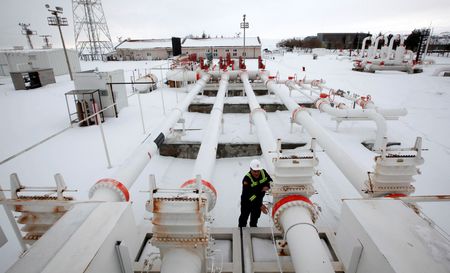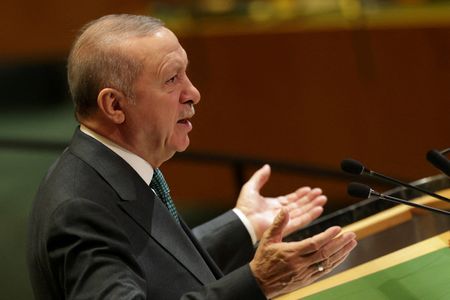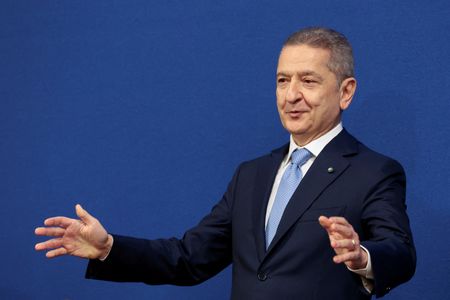By Can Sezer
ISTANBUL (Reuters) -Turkey could meet more than half of its gas needs by the end of 2028 by ramping up production and increasing U.S. imports, in a shift that threatens to shrink the last major European market for Russian and Iranian suppliers.
Washington has publicly pressured allies, including NATO member Turkey, to cut energy ties with Moscow and Tehran. At their White House meeting on September 25, U.S. President Donald Trump pressed Turkish President Tayyip Erdogan to cut Russian energy purchases.
Diversifying supply would also strengthen Turkey’s energy security and support its ambitions to become a regional gas hub. Ankara aims to re-export imported liquefied natural gas and its own gas production to Europe while burning Russian and Iranian gas domestically, analysts said.
“Turkey has been signalling that it will take advantage of the (global) LNG abundance,” said Sohbet Karbuz, from the Paris-based Mediterranean Organisation for Energy and Climate.
Russia remains Turkey’s largest gas supplier, but its share of the market has fallen from more than 60% two decades ago to 37% in the first half of 2025. Most European countries halted imports following Moscow’s invasion of Ukraine in 2022.
RUSSIA’S PIPELINE CONTRACTS NEAR EXPIRY
Russia’s long-term pipeline contracts with Turkey to supply 22 billion cubic metres (bcm) annually via the Blue Stream and TurkStream pipelines are close to expiry. Iran’s 10 bcm contract expires in the middle of next year, while Azerbaijan’s contracts, totalling 9.5 bcm, run until 2030 and 2033.
While Turkey is likely to extend some of these contracts, it is likely to seek more flexible terms and smaller volumes to increase the diversity of its supply, Karbuz said.
At the same time, Turkey is rapidly expanding alternative sources. State-owned TPAO is boosting output from local gas fields, while state and private companies have expanded LNG import terminals to bring gas in from the U.S. and Algeria.
Domestic production and contracted LNG imports are set to exceed 26 bcm annually from 2028 from 15 bcm this year, according to Reuters calculations.
US LNG IMPORTS SET TO DOUBLE
That would cover more than half of Turkey’s gas demand of around 53 bcm, reducing the gap for pipeline imports to around 26 bcm – well below the 41 bcm of current contracted supplies from Russia, Iran and Azerbaijan combined.
To support this shift, Turkey has signed a series of LNG deals with U.S. suppliers worth $43 billion, including a 20-year agreement with Mercuria in September.
The country has built 58 bcm annual LNG import capacity, enough to cover its entire demand, according to Turkey’s energy exchange.
Despite this, Russian gas continues to flow at full capacity, and the Kremlin has said cooperation with Ankara remains strong.
Since Turkey needs less Russian gas, BOTAS could, in theory, stop imports from Moscow in two to three years, said Alexey Belogoryev of the Moscow-based Institute for Energy and Finance.
“However, it won’t do so, because Russian gas is price-competitive and creates a surplus that BOTAS can use to pressure other suppliers,” Belogoryev said.
Turkey’s energy minister Alparslan Bayraktar said in a TV interview in October that Turkey must source gas from all available suppliers, including Russia, Iran and Azerbaijan, but noted that U.S. LNG offers cheaper alternatives.
The energy ministry declined to comment on future supply deals and pricing. Russian gas pipeline export monopoly Gazprom did not reply to a request for comment.
Turkey could burn Russian and Iranian gas at home, export its own production and re-export imported LNG after Europe bans Russian energy imports by 2028, said Karbuz.
Turkey’s BOTAS has already signed deals to supply Hungary and Romania with small volumes of gas in its bid to become a regional gas trading hub.
Beyond gas, Ankara has deep ties with Moscow. Russia’s Rosatom is building Turkey’s first nuclear plant and Moscow is also the country’s top crude and diesel supplier.
(Reporting by Can Sezer; Editing by Jonathan Spicer and Louise Heavens)











